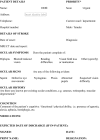Vision In Stroke cohort: Profile overview of visual impairment
- PMID: 29201538
- PMCID: PMC5698855
- DOI: 10.1002/brb3.771
Vision In Stroke cohort: Profile overview of visual impairment
Abstract
Aim: To profile the full range of visual disorders from a large prospective observation study of stroke survivors referred by stroke multidisciplinary teams to orthoptic services with suspected visual problems.
Methods: Multicenter prospective study undertaken in 20 acute Trust hospitals. Standardized screening/referral forms and investigation forms documented data on referral signs and symptoms plus type and extent of visual impairment.
Results: Of 1,345 patients referred with suspected visual impairment, 915 were recruited (59% men; mean age at stroke onset 69 years [SD 14]). Initial visual assessment was at median 22 days post stroke onset. Eight percent had normal visual assessment. Of 92% with confirmed visual impairment, 24% had reduced central visual acuity <0.3 logMAR and 13.5% <0.5 logMAR. Acquired strabismus was noted in 16% and acquired ocular motility disorders in 68%. Peripheral visual field loss was present in 52%, most commonly homonymous hemianopia. Fifteen percent had visual inattention and 4.6% had other visual perceptual disorders. Overall 84% were visually symptomatic with visual field loss the most common complaint followed by blurred vision, reading difficulty, and diplopia. Treatment options were provided to all with confirmed visual impairment. Targeted advice was most commonly provided along with refraction, prisms, and occlusion.
Conclusions: There are a wide range of visual disorders that occur following stroke and, frequently, with visual symptoms. There are equally a wide variety of treatment options available for these individuals. All stroke survivors require screening for visual impairment and warrant referral for specialist assessment and targeted treatment specific to the type of visual impairment.
Keywords: central vision; ocular motility; stroke; visual field loss; visual impairment; visual inattention; visual perception; visual symptoms.
Figures
References
-
- Adler, P. (2002). Efficacy of treatment for convergence insufficiency using vision therapy. Ophthalmic and Physiological Optics, 22(6), 565–571. - PubMed
-
- British and Irish Orthoptic Society . (2016). British and Irish Orthoptic Society position statement for orthoptic stroke services. http://www.parallelvisionmatters.org.uk/index.php/stroke-neurological-de... Accessed 22nd April 2016.
-
- Carruthers, J. D. , Kennedy, R. A. , & Bagaric, D. (1990). Botulinum versus adjustable suture surgery in the treatment of adult patients lacking fusion. Archives of Ophthalmology, 108(10), 1432–1535. - PubMed
-
- Firth, A. Y. , & Whittle, J. P. (1994). Clarification of the correct and incorrect use of ophthalmic prisms in the measurement of strabismus. British Orthoptic Journal, 51, 15–18.
-
- Hepworth, L. , & Rowe, F. J. (2016). Visual impairment following stroke – the impact on quality of life: a systematic review. Ophthalmology Research: An International Journal, 5(2), 1–15.
Publication types
MeSH terms
LinkOut - more resources
Full Text Sources
Other Literature Sources
Medical



